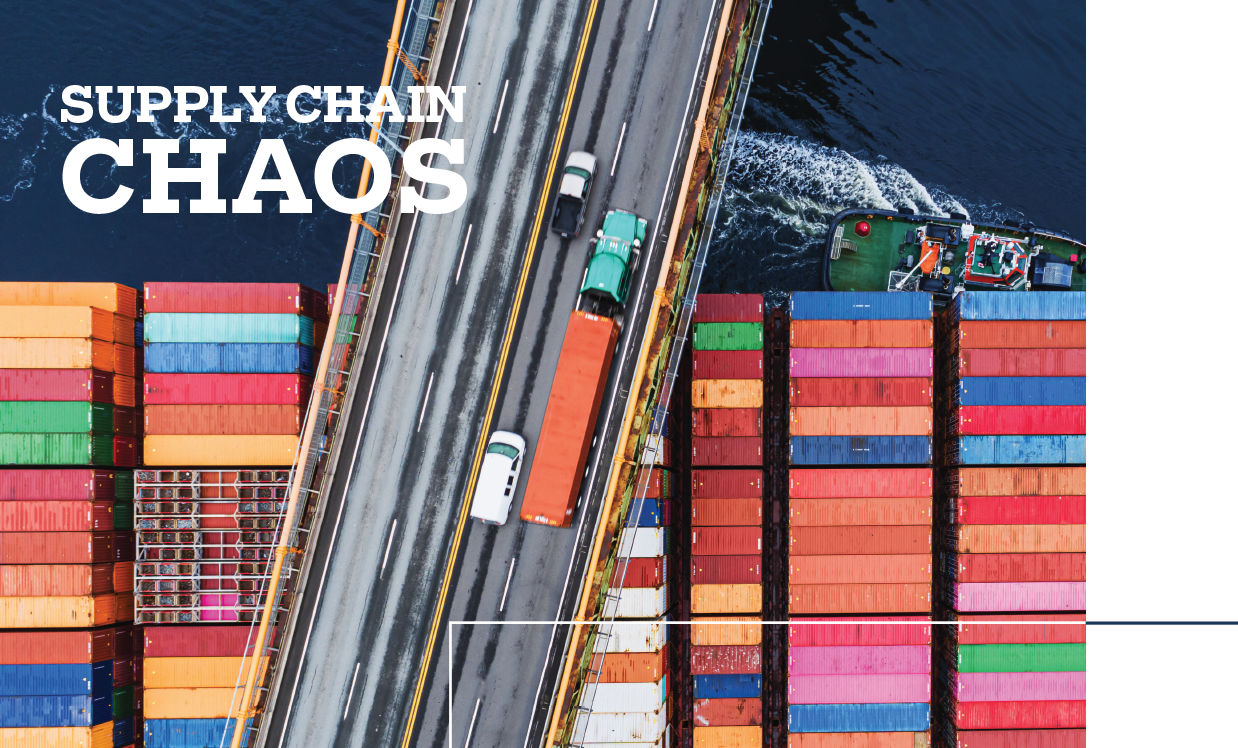
|
First it was toilet paper and flour. Then it was lumber, home gym equipment and homeschool supplies. Now it’s semiconductor chips, groceries and parts needed for home improvement projects, including roof systems. What started as various industry hiccups at the beginning of the COVID-19 pandemic has evolved into a full-blown breakdown in the global supply chain.
Rising construction material costs and lack of availability is making it difficult to provide estimates for roofing projects, let alone complete them. Roofing companies are struggling to get projects started, and major roofing projects are being put on hold. To navigate through the supply chain crisis, it’s helpful to know how the industry got to this point, its current state and where it’s headed.
A global problem
Unfortunately, there is no historical precedent for the current supply chain shortage, according to David Dreyfus, an assistant professor in the department of supply chain management at Rutgers Business School in Newark, N.J. The world was not globalized during the 1918 flu pandemic as it is now. Dreyfus notes even the pharmaceutical shortages experienced after Hurricane Maria in 2017 that affected Puerto Rico’s manufacturing sector only lasted a few months.
“The entire world experienced the same disruption, this pandemic,” Dreyfus said in a November 2021 New England Cable News article. “So instead of it being isolated to a natural disaster like a hurricane or tsunami where it’s just one area of the world, the entire world closed down.”
Supply chain problems are not new; they existed before the pandemic. There was a shortage of drivers to transport supplies, and online shopping increased the number of goods to be delivered, according to Douglas Hales, a professor of operations and supply chain management at University of Rhode Island’s College of Business, South Kingstown. Even with ports in Los Angeles and Long Beach, Calif., operating at capacity, there still are too few truckers, not enough workers in warehouses and distribution centers, and other logistical problems.
“Ships are waiting to unload, and port operators say companies are not picking up their goods quickly enough,” Hales says. “Truckers report delays with crane operators and say they are stymied by cross-country trucking regulations. Those rules merit a review.”
The head of the Teamsters union in the Los Angeles and Long Beach port areas says supply chain problems are complex.
“The problem is the way the trucking industry in the [Los Angeles and Long Beach] port area is done,” said Teamsters General President Jim Hoffa during a Dec. 8, 2021, Zoom presentation. “It’s being done on the terrible, terrible basis of [employee] misclassification. It’s rotten to the core, and that’s why truckers are not showing up. I don’t blame them.”
During the presentation led by the union, according to the Los Angeles Daily News, Hoffa said the problem isn’t too few drivers but rather a system in which drivers must bear much of the financial burden themselves, including paying for trucks and fuel while having no regular employee benefits, such as sick pay or health insurance.
Los Angeles Daily News reports Hoffa has spoken with the Biden administration’s new labor secretary, Marty Walsh, a former union president, and said he’s hopeful something might be done to rectify the situation. California Senate Bill 338, which took effect Jan. 1, penalizes cargo owners who use companies with drivers who aren’t employees. However, another piece of legislation, California Assembly Bill 794, would disqualify trucking companies from receiving funding for clean trucks.
“It’s a big battle,” Hoffa said. “It’s going to be a battle all the way.”
Despite the supply chain crisis, Los Angeles-area ports are on track for a record year, according to L.A. Biz. As of Dec. 15, 2021, more than 18.5 TEUs (20-foot equivalent units) have moved through San Pedro Bay—up 18.5% from the first 11 months of 2020.
Domestic issues
Compared with other industries, the U.S. roofing industry is mostly domestic in nature. A vast majority of roofing products and materials used are manufactured in the U.S. from U.S.-sourced raw materials by U.S. suppliers and distributors and installed by U.S. roofing contractor companies. Although the global economy has some effect on many purchasing decisions, the U.S. roofing industry is largely driven by the U.S. economy, interest rates and consumer sentiment.
During the past decade, the U.S. roofing industry has experienced consistent, moderate growth. The materials and products supply chain has expanded, and field personnel have been added to fill the growing need. In many regions, growth has been limited by a lack of adequately trained field personnel.
At the same time, energy code requirements and sustainability incentive programs have resulted in a demand for more energy-efficient roof systems. Mandated increases in insulation values necessitate thicker and greater amounts of insulation resulting in demand for additional materials and installation labor.
By many measures, 2020 was a productive year for the U.S. roofing industry. For example, 2020 was a near-historic record year for asphalt shingle roof system installations. Homeowners invested in reroofing and maintaining their homes during the pandemic, and the roofing industry responded to several weather events involving high winds and hail. Institutional and industrial segments of the U.S. roofing industry experienced similar activity.
But one noticeable change that came with the pandemic is the roofing material and product inventory shrunk considerably as some material suppliers and distributors reduced their inventories during the earliest days of the pandemic. Since the start of the pandemic, far more roofing materials and products are being shipped on a job-specific basis, especially roof insulation, roof covering products and certain specialty products such as fasteners and adhesives.
At the end of 2020, there was a degree of uncertainty in the U.S. economy and within the roofing industry. Contractors were unsure whether roofing would be deemed an “essential” business, and U.S. roofing manufacturers, distributors and contractors placed minimal orders for materials and products. As a result of reduced demand, manufacturers scaled back their off-season production. Because of this, inventories were uncharacteristically low at the start of the 2021 roofing season.
NRCA was successful in lobbying for roofing to be classified as an essential business, and by February 2021, demand for roofing rebounded in many areas of the U.S. Roofing contractors’ backlogs of work grew significantly spurred by low interest rates and stimulus funding. By March, roofing material shortages were common, and prices were increasing significantly and continue to fluctuate as demand for roofing services is high.
On Sept. 22, 2021, NRCA held a Telephone Town Hall featuring leaders of significant industry manufacturers who shared updates and answered questions regarding the supply chain crisis. During the town hall, manufacturers raised a concern about “ghost orders,” where contractors placed orders with several suppliers for the same job or for materials that would not be used right away, which resulted in excess materials in some contractors’ warehouses while others awaited materials.
Despite ordering issues, asphalt shingle production and installation remained extremely high during 2021, and roofing contractors in many regions are reporting significant backlogs of work well into 2022.
Manufacturers are reporting similar demand with anticipated lead times for fulfilling new orders between four and 12 months or longer. Shortages of materials and products are at the point where availability is limiting the ability to perform roofing work to a greater extent than a lack of adequately trained field personnel, a problem that has plagued the industry for years.
It should be no surprise manufacturing prices go up because raw material prices go up. In some cases, the timing for determining the price roofing contractors pay for materials and products also has changed. Recently, several manufacturers have instituted new policies basing pricing at the time of shipment rather than at the time the order is placed. As a result, roofing contractors don’t have accurate material and product pricing at the time they prepare a proposal or bid for a homeowner or building owner. This is an obvious problem for roofing contractors as well as homeowners and building owners because there is likely potential for more price increases.
According to the Associated Builders and Contractors, through November 2021, nonresidential construction material prices increased 24.5% compared with one year ago. Softwood lumber prices have fluctuated wildly and are up 3.5% year-over-year and up 6% from October to November 2021. Iron and steel prices are up 105.1% year-over-year and 3.6% from October to November 2021.
“There is no indication material prices will fall in the near future,” says ABC Chief Economist Anirban Basu. “With the Omicron variant now circulating around the world and leading to a wave of lockdowns and supply chain disruptions, demand for key commodities will continue to exceed supply. Among the implications is that estimators will be under enormous pressure to predict materials prices amid enormous volatility and uncertainty. Many ABC members expect profit margins to decline over the next several months.”
Further exacerbating the supply chain problem, in some situations, such as the aftermath of Hurricane Ida in 2021, roofing manufacturers were faced with declarations of force majeure (unforeseeable circumstances) regarding supply contracts and shipments from raw material providers, causing raw material slowdowns. In some cases, manufacturers need to find alternative raw material sources, resulting in stoppages in material and product manufacturing that likely have notable effects on material and product pricing.
Similar to other industries, the roofing industry continues to feel the effects of shortages of delays in and high pricing for transporting roofing materials and products from manufacturers to suppliers and distributors, roofing contractors’ warehouses and job sites. NRCA expects roofing material and product shortages, long lead times and significant price volatility to continue through this year.
TAKEAWAYS
Commercial property insurer and supply chain resilience expert FM Global® identified six facets of the current supply chain crisis and takeaways:
In May 2021, FM Global released its 2021 FM Global Resilience Index designed to help organizations optimize their supply chains by providing data regarding the relative resilience of countries’ and territories’ business environments. The report is available at fmglobal.com.
Moving forward
To help alleviate supply chain issues, some manufacturers, such as Owens Corning, Toledo, Ohio, are ramping up manufacturing. The company’s plans for 2022-23 include a multimillion-dollar investment that will increase capacity across its shingle plant network, adding the equivalent of a full shingle line to its shingle production capability. In addition, the company will make significant investments in increased inventory levels and warehousing to meet demand surges during peak seasons.
“Given the industry’s fiberglass mat constraints, we are also excited to share that we have announced an expansion to our fiberglass mat facility in Arkansas that will significantly expand our mat capacity starting in 2023,” says Gunner Smith, president of roofing for Owens Corning. “These investments will increase our production capacity in our roofing accessory products as well, supporting the growth of our Total Protection Roof System.”
NRCA will continue to monitor the supply chain crisis and keep the industry apprised of developments. You can find more information on NRCA’s dedicated supply chain shortage information webpage at nrca.net/resources/supply-chain-shortage. This section provides up-to-date news and what you can expect to see in the coming months, as well as a suggested price acceleration clause for your contracts to address unforeseen price increases and a recording of an NRCA supply chain webinar with industry leaders.
NRCA encourages you to share this information with your homeowner and building owner clients, building managers, general contractors and construction managers involved in roof purchasing decisions.
CHRYSTINE ELLE HANUS is Professional Roofing’s associate editor and an NRCA director of communications. MARK S. GRAHAM is NRCA's vice president of technical services.



